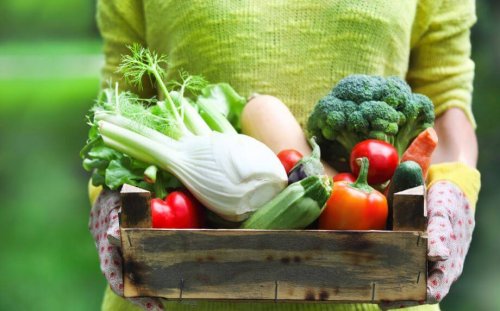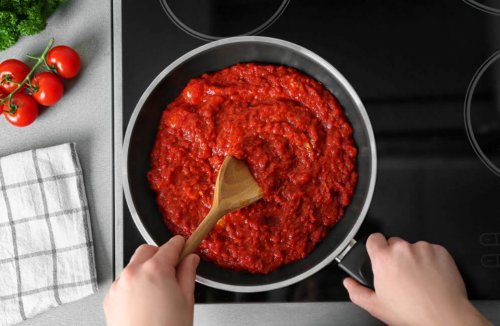Benefits of Making Veggie Sauces

Veggie sauces are a great option as a base for a variety of dishes, due to the nutritious value of the ingredients.
In order to eat even healthier veggie sauces, you can make them at home. Keep reading for some easy and delicious recipes that you can try.
Apart from veggie sauces contributing to the daily intake of important nutrients, they can add color, texture and flavor to your dishes.
Veggies that are high in fiber help us regulate our cholesterol and sugar levels and prevent constipation.

Vegetables are a great source of vitamins, minerals and other substances that improve our immune system, which then helps us to prevent all kinds of illnesses.
To get the most out of vegetables, you should eat them raw, but you can also cook them in a small amount of oil and add them to your sauces. By doing this, you’re more likely to keep eating them, and therefore maintain a healthy weight and a balanced diet.
Benefits and types of vegetables
Bulb vegetables, such as garlic, onions, scallions and leeks, stimulate digestion, favor the process of breathing, are detoxifying and have substances that help us to prevent illnesses associated with age.
Similarly, bitter vegetables also help with digestion: artichokes, endive, borage, spinach and thistle. While colorful vegetables are the perfect source of vitamins: tomatoes, bell peppers, carrots and pumpkins.
All veggies provide us with fiber, vitamins, minerals and water, which helps us to stay healthy and hydrated. Here we have gathered some tasty recipes to make veggie sauces at home- easy and delicious!
Veggie sauces for pasta
Ingredients (makes four servings):
- One cup of previously peeled tomatoes. Dice them in small cubes.
- One cup of carrots. Wash them and dice them in small cubes, just as you did with the tomatoes.
- One zucchini, peeled and diced in cubes.
- One cup of onion, finely chopped.
- Two garlic cloves, minced.
- One cup of vegetable broth.
- 4 tablespoons of olive oil.

Directions:
First put the olive oil in a pan. Prepare the veggies in the following order:
- Carrots
- Zucchini
- Onion
- Garlic
- Tomatoes
Put the pan on a medium heat and when the oil is hot, add the veggies in the order that we mentioned before. Cook each vegetable for four minutes and then add the next one. Stir with a wooden spoon until they’re golden brown.
When the tomatoes are crushed and juicy, and the veggies are ready, lower the heat, add the broth and stir until it’s all mixed together.
After letting it simmer for three minutes, add spices of your choosing, such as oregano, paprika, or basil, and just a pinch of salt to taste.
Finally, turn the heat off and serve on top of pasta.

Zucchini and tomato sauce
Ingredients (makes six servings):
- One onion
- A garlic clove
- Large carrot
- One green bell pepper
- A small red chili pepper
- A zucchini
- One eggplant
- Three dried tomatoes
- Seven fluid ounces of red wine
- One pound of crushed tomatoes
- Three tablespoons of sugar
- Black ground pepper
- Salt
- Dried oregano
- Extra virgin olive oil
- Parmesan cheese
Directions:
Start by peeling the onion and garlic, and finely chop them. Wash the rest of the veggies and chop these as well, then set aside.
Heat up some olive oil in a deep pan and add the onion and a pinch of salt. Cook for a couple of minutes.
Afterward, add the garlic and stir for a minute, then add the carrot, the bell pepper and the dried tomatoes (that you previously soaked for some time) and let it all cook together for about eight minutes.
Add the zucchini and eggplant, salt and pepper and sautee until they turn golden brown. Then throw in the crushed tomatoes, the sugar and the red wine.
Let it boil, cover with a lid and cook for 20-30 minutes at a low heat temperature, and stir every few minutes. Finally add some of the boiling water used to make the pasta, if needed.
Veggie sauces are a great option as a base for a variety of dishes, due to the nutritious value of the ingredients.
In order to eat even healthier veggie sauces, you can make them at home. Keep reading for some easy and delicious recipes that you can try.
Apart from veggie sauces contributing to the daily intake of important nutrients, they can add color, texture and flavor to your dishes.
Veggies that are high in fiber help us regulate our cholesterol and sugar levels and prevent constipation.

Vegetables are a great source of vitamins, minerals and other substances that improve our immune system, which then helps us to prevent all kinds of illnesses.
To get the most out of vegetables, you should eat them raw, but you can also cook them in a small amount of oil and add them to your sauces. By doing this, you’re more likely to keep eating them, and therefore maintain a healthy weight and a balanced diet.
Benefits and types of vegetables
Bulb vegetables, such as garlic, onions, scallions and leeks, stimulate digestion, favor the process of breathing, are detoxifying and have substances that help us to prevent illnesses associated with age.
Similarly, bitter vegetables also help with digestion: artichokes, endive, borage, spinach and thistle. While colorful vegetables are the perfect source of vitamins: tomatoes, bell peppers, carrots and pumpkins.
All veggies provide us with fiber, vitamins, minerals and water, which helps us to stay healthy and hydrated. Here we have gathered some tasty recipes to make veggie sauces at home- easy and delicious!
Veggie sauces for pasta
Ingredients (makes four servings):
- One cup of previously peeled tomatoes. Dice them in small cubes.
- One cup of carrots. Wash them and dice them in small cubes, just as you did with the tomatoes.
- One zucchini, peeled and diced in cubes.
- One cup of onion, finely chopped.
- Two garlic cloves, minced.
- One cup of vegetable broth.
- 4 tablespoons of olive oil.

Directions:
First put the olive oil in a pan. Prepare the veggies in the following order:
- Carrots
- Zucchini
- Onion
- Garlic
- Tomatoes
Put the pan on a medium heat and when the oil is hot, add the veggies in the order that we mentioned before. Cook each vegetable for four minutes and then add the next one. Stir with a wooden spoon until they’re golden brown.
When the tomatoes are crushed and juicy, and the veggies are ready, lower the heat, add the broth and stir until it’s all mixed together.
After letting it simmer for three minutes, add spices of your choosing, such as oregano, paprika, or basil, and just a pinch of salt to taste.
Finally, turn the heat off and serve on top of pasta.

Zucchini and tomato sauce
Ingredients (makes six servings):
- One onion
- A garlic clove
- Large carrot
- One green bell pepper
- A small red chili pepper
- A zucchini
- One eggplant
- Three dried tomatoes
- Seven fluid ounces of red wine
- One pound of crushed tomatoes
- Three tablespoons of sugar
- Black ground pepper
- Salt
- Dried oregano
- Extra virgin olive oil
- Parmesan cheese
Directions:
Start by peeling the onion and garlic, and finely chop them. Wash the rest of the veggies and chop these as well, then set aside.
Heat up some olive oil in a deep pan and add the onion and a pinch of salt. Cook for a couple of minutes.
Afterward, add the garlic and stir for a minute, then add the carrot, the bell pepper and the dried tomatoes (that you previously soaked for some time) and let it all cook together for about eight minutes.
Add the zucchini and eggplant, salt and pepper and sautee until they turn golden brown. Then throw in the crushed tomatoes, the sugar and the red wine.
Let it boil, cover with a lid and cook for 20-30 minutes at a low heat temperature, and stir every few minutes. Finally add some of the boiling water used to make the pasta, if needed.
This text is provided for informational purposes only and does not replace consultation with a professional. If in doubt, consult your specialist.








